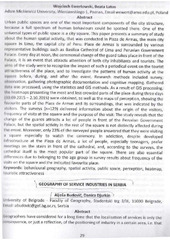Приказ основних података о документу
Geography of service industries in Serbia
| dc.contributor | Petre, Bretcan | |
| dc.contributor | Dumitru Danut, Tanislav | |
| dc.contributor | Costache, Andra | |
| dc.contributor | Muratoreanu, George | |
| dc.creator | Budović, Aljoša | |
| dc.creator | Đurkin, Danica | |
| dc.date.accessioned | 2023-03-09T11:39:21Z | |
| dc.date.available | 2023-03-09T11:39:21Z | |
| dc.date.issued | 2016 | |
| dc.identifier.issn | 2457-1849 | |
| dc.identifier.uri | http://gery.gef.bg.ac.rs/handle/123456789/1203 | |
| dc.description.abstract | Geographers have considered for a long time that the localisation of services is only the consequence, or just a reflection, of the positioning of industry in a certain area, i.e. that the spatial patterns of the positioning of services can be explained through distribution of industries. Influences by this opinion, geographers for a long time had no interest in services. Only with the modern internationalization of services and by appearing of thesis that wealth is not represented only by objects that could be owned, but also by the possibilities to satisfy one's needs, was this widespread opinion in geography confuted: the opinion that the services represent parasitic consumer of valuables created by the productive primary and secondary sectors, that can not be exported, but are exclusively tied to their area of origin. Geographic studies about the industry of services in the transitional countries are of utmost importance. The countries of former Eastern Bloc entered the transitional period with underdeveloped and limited sector of services, just for this sector to experience the most visible changes. During the centrally-planning system, the development of industry was favored. The companies were protected from national or international competition, and this in turn had negative influence on the development of entrepreneurship, innovations, etc. With the start of the reform process, new services (that were unavailable before) emerged, the market was opened for international companies; the services of large industrial companies were externalized, etc. Serbia, unlike many other former Eastern Bloc countries, entered this transitional process later (in the early 2000s), and this influenced the over-all development of country, as well as the development of the sector of services. The goal of this study is to research the effects of delayed transition process in Serbia on the development of service industry, the role of the services in this process in urban and regional development of Serbia, as well as to investigate the progress of the sector of services in Serbia, compared to the services of other transitional countries. | sr |
| dc.language.iso | en | sr |
| dc.publisher | Department of Geography, Valahia University of Targoviste | sr |
| dc.publisher | Romanian Limnogeographical Association and Institute of Geography - Romanian Academy | sr |
| dc.rights | openAccess | sr |
| dc.rights.uri | https://creativecommons.org/licenses/by/4.0/ | |
| dc.source | Book of abstracts of the 3rd International Conference "Geography, Environment and GIS, for students and young researchers", Targoviste, Romania | sr |
| dc.subject | services | sr |
| dc.subject | transition countries | sr |
| dc.subject | regional development | sr |
| dc.subject | Serbia | sr |
| dc.title | Geography of service industries in Serbia | sr |
| dc.type | conferenceObject | sr |
| dc.rights.license | BY | sr |
| dcterms.abstract | Будовић, Aљоша; Ђуркин, Даница; | |
| dc.citation.spage | 29 | |
| dc.citation.epage | 30 | |
| dc.identifier.fulltext | http://gery.gef.bg.ac.rs/bitstream/id/2875/Geography_of_service.pdf | |
| dc.identifier.rcub | https://hdl.handle.net/21.15107/rcub_gery_1203 | |
| dc.type.version | publishedVersion | sr |


